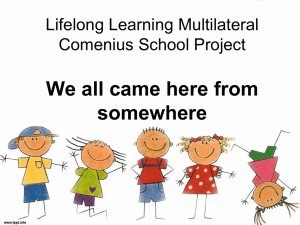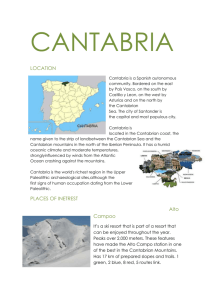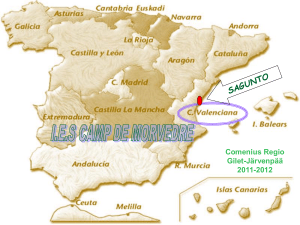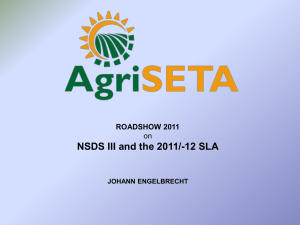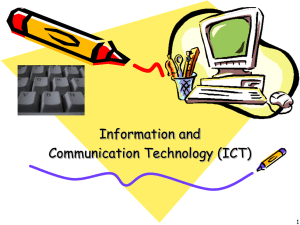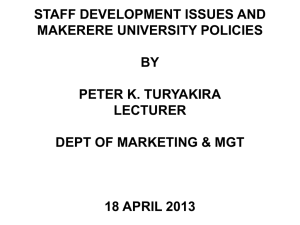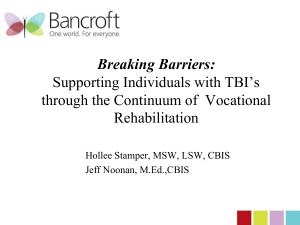Activities in school to support the youngsters in the risk group
advertisement
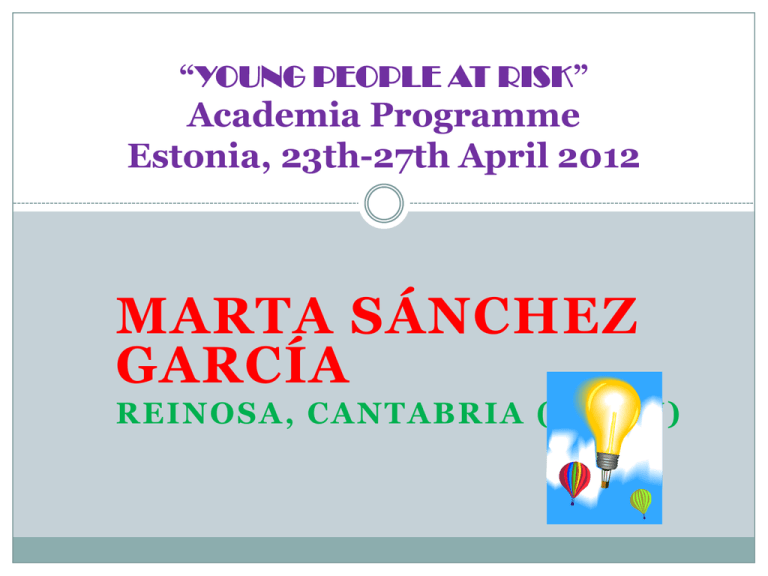
“YOUNG PEOPLE AT RISK” Academia Programme Estonia, 23th-27th April 2012 MARTA SÁNCHEZ GARCÍA REINOSA, CANTABRIA ( SPAIN) A PERSPECTIV E OF MEASURES IN SECONDARY SCHOOL IN SPAIN Reinosa, Cantabria, 2012 Young people at risk PROGRAMMES AND OTHER IDEAS FROM CANTABRIA, SPAIN OBJECTIVES: To show the education system in Spain and in Cantabria. To focus on the levels where the majority of young people at risk are To reflect the aims and perspectives of two specific Programmes: PCPI (First Professional Training Programme) and COMPENSATORIA To underline the main problems that young people at risk have to face nowadays CONTENTS: Spain , Cantabria and Reinosa: map of location&pictures The education system in Spain&Cantabria Where I work: MONTESCLAROS High School Reasons why some young people are at risk What is being done from educational system What is being done at my High School COMPENSATORIA PCPI (First Professional Training Programmes) Other activities that can be done with students WHERE ARE WE?... Cantabria in Europe Cantabria region SOME FACTS ABOUT REINOSA AND CAMPÓO VALLEY We are in the South of Cantabria, in a mountainous area (858m above sea level)but not far from the sea There are 12.000 inhabitants in Reinosa It´s an industrial area (with two main factories in which a great number of workers from the area have their regular job)with an important natural environment as well as cultural and artistical heritage Reinosa is the capital of different valleys with small and sometimes isolated villages. SOME IMAGES OF OUR LAND… The town (Reinosa) …and its traditions…. ….our mountains…. …and the valley… MONTESCLAROS High School www.iesmontesclaros.es THE EDUCATION SYSTEM THE SPANISH EDUCATION SYSTEM…. IS DEFINED BY THE MINISTRY OF EDUCATION AND SCIENCE HAS A UNIFORM STRUCTURE ALL OVER THE COUNTRY HOWEVER, EVERY AUTONOMOUS REGION (Cantabria among them) DEVELOPS AND FITS THIS STRUCTURE TO ITS OWN PARTICULAR NEEDS THE EDUCATION SYSTEM To simplify, we can divide the education offers into three large sections: COMPULSORY EDUCATION NON-COMPULSORY EDUCATION SPECIALISED EDUCATION (Fine Arts&Languages) In Cantabria, the authority in charge of the Education System is the County Education Department (Consejería de Educación) COMPULSORY EDUCATION Applies to ages 6-16 1) PRIMARY SCHOOL (6-12)) -- Divided into six courses 2) COMPULSORY SECONDARY EDUCATION (12-16) -- Divided into four courses. In every course there are common compulsory subjects as well as optional subjects (Compulsory Secondary Education-ESO) After passing all the subjects, the student is awarded with the SECONDARY EDUCATION DEGREE. This allows him/her to…. a) Continue his studies….A) With MEDIUM GRADE VOCATIONAL, or B) With BACHILLERATO. b) Or start working (this is the basic degree for entering the workforce). NON-COMPULSORY EDUCATION Is the education offered before and after the compulsory schooling 1) Before: PRE-SCHOOL EDUCATION (ages 2-6) 2) After: BACHILLERATO VOCATIONAL TRAINING UNIVERSITY (Non-compulsory education) BACHILLERATO UNIVERSITY Qualification for university Access is granted after access, or for the Higher Grade of Vocational Training. Duration of two academic years . There are three types: Arts, Science and Technology and Humanities and Social Sciences. passing the admission test (Selectividad). A Bachillerato degree is also required. Access is also granted to graduates of Higher Grade Vocational Training and to those who pass and admission test for applicants older than 25 years old. VOCATIONAL TRAINING (Formación Profesional) THE MEDIUM GRADE (Grado Medio) can be accessed with the Secondary Education Degree (16 years old) , or through an exam. THE HIGHER GRADE (Grado Superior) can be accessed after finishing Bachillerato (18 years old), or through an exam. Every courses provides specialised training for a very specific career. The duration of every course varies between one and a half and two academic years. At the end of their period at school, they have 3 month practice in a real company. STUDENTS WITH SPECIAL NEEDS In our education system, we understand that every student, any moment during his/her schooltime, may need more help than usual to achieve his/her objectives in school. Some measures for these needs may be: to take extra lessons, to learn in samller groups, etc . But sometimes students have even more specific needs, such as hendicapped students, students who have joined school very late or students who don´t speak Spanish. COMPENSATORIA and PCPI are considered as some of the specific Programmes to take care of these students who have special needs in the sense that they haven´t achieved yet the goals of compulsory education in the “normal way”. Thus, they are considered as YOUNG PEOPLE AT RISK. REASONS WHY SOME YOUNG PEOPLE ARE AT RISK General reasons: bad economic situation, economic crisis, very high unemployement rates, especially among young people (more than 50%). Social and family reasons: defavorised backgrounds, rural areas with few oportunities, low cultural level. Geographic and cultural reasons: isolation of some villages, importance of very specific professional areas. School reasons: integration difficulties, bullying. Personal reasons: lack of motivation, low self-steem, difficulties in learning, bad companies, alcohol, drugs. COMPENSATORIA Programme This is an extraordinary Programme that may be developped by a High School in case there are students who have all the following conditions: Families&backgrounds in social disadvantage Serious risk of drop out, non-attendance to school and/or social exclusion To have an academic delay of at least two years To have previously received ordinary measures that hadn´t been enough to compensate his/her difficulties (Compensatoria Programme) Then different steps have to be followed, such as Psicopedagogical evaluation of the student (by the Guidance Department), information to families, as well as positive report by the Educational Inspection Service. The target group are 1st and 2nd courses of Compulsory Secondary Education. (COMPENSATORIA Programme): WHAT DOES THE PROGRAMME CONSIST OF? The students create an specific group (8-12 students normally) for some subjects, (Language, Maths…) plus 1hour of specific tutorial activities, as well as social and emotional skills workshop. (21 hours) They are with the general group for the rest of the subjects,(Music, Technology. (9 hours) These 21 hours are organised in a different way than normal, by creating global groups of learning (Social and Language Area, Maths and Science area), using a more global approach to subjects, as well as adapted materials, methodology and strategies. They tend to do more team work, as well as project working. Evaluation is also adapted, it is a continuous and formative process. (COMPENSATORIA Programme) They also have some kind of workshop, with practical job mainly, which is very important for their motivation. The school can choose among many different items: computers, gardening, car repairing… COMPENSATORIA Programme: summarising the main objectives To avoid their drop out. From the system. To improve their learning as well as social and affective skills. To favorise their academic progress through different methods of teaching. To permit their integration in the education system, either through a “DIVERSIFICACIÓN Programme”(similar structure to Compensatoria but for 3rd and 4th year of Compulsory Education) or PCPI (First Professional Training Programmes). FIRST PROFESSIONAL TRAINING PROGRAMMES (PCPI) Target group: young people between the age of 16 and 20 who did not achieve the Secondary Education Degree. Objective of the programme: to provide these studentswith a basic and professional training which allows them to either join the workforce or to beghin further studies. On finishing the programme, the centre will issue a certificate where the amount of hours and the obtained qualifications will be shown. This certificate gives access to job market and to Medium-Grade Vocational Training after passing an access test. FIRST PROFESSIONAL TRAINING PROGRAMMES (PCPI) First Year • They have general subjects (Language, Maths,…but with a global approach structure), as well as Social and Work Skills Workshop, and then 8 hours of Professional Workshop. They have also 1 month practice in a company. Second Year (volontary) • If they do it, they obtain Secondary Education Degree. (First year doesn´t give them this, but they can do it through an exam). FIRST PROFESSIONAL TRAINING PROGRAMMES (PCPI) OBJECTIVES: To prevent drop-out and non-attendance. To look for a different way of obtaining the Graduate in Secondary Education for those students who haven´t achieved at first. To motivate through a professional approach, those students who didn ´t find the attractive in the normal system. To prepare students either to work or to continue studies in Vocational Training. Workshops of PCPI (First Professional Training Programmes) Workshops of PCPI (First Professional Training Programmes) “THE BOOK WEEK”, to encourage them to read different types of books and getting involved in the school library…… OTHER COMPLEMENTARY ACTIVITIES (ORGANISED BY THE DIFFERENT DEPARTMENTS, IN COOPERATION WITH THE GUIDANCE DEPARTMENT) Information about how to create your own business or how to go abroad…. …SHOWING OUR WORKSHOPS, to students, parents and community in general… …and other varied activities such as preparing food for students and teachers to celebrate the end of accademic year!! SOME WEB PAGES WE NORMALLY USE www.educantabria.es www.jovenamnia.com www.empleacantabria.com • http://www.facebook.com/#!/profile.php?id=10000 0203513036 THANK YOU VERY MUCH!
